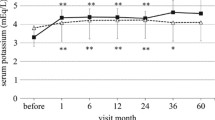Abstract
Dapagliflozin (DAPA), a sodium–glucose co-transporter 2 (SGLT2) inhibitor, is known to have a beneficial diuretic effect, in addition to a glucose-lowering effect. Although SGLT2 inhibitor has been reported, the increase of hyperkalemia in patients treated with renin–angiotensin–aldosterone system (RAAS) inhibitors, their mechanism of action is unclear. We report the first case of a type 2 diabetes (T2DM) patient with potential mineralocorticoid deficiency who developed hyperkalemia after administration of DAPA. A 79-year-old woman underwent bilateral adrenalectomy for uncontrolled hypercortisolism due to an inoperable recurrence of Cushing’s disease, and she was subsequently maintained on replacement therapy with glucocorticoid. She was diagnosed as having T2DM at 71 years of age and was treated with sitagliptin and miglitol. Since she presented with weight gain of about 5 kg over 6 months and her HbAlc level increased over 12%, 5 mg/day DAPA was added to her daily regimen. After the start of DAPA treatment, she developed hyperkalemia (6.5 mEq/L) with increased plasma renin activity of 53.1 ng/mL/h. She was diagnosed with aldosterone deficiency and started on fludrocortisone 0.1 mg daily, after which the hyperkalemia improved immediately. In this case, DAPA treatment could potentially increase the requirement for mineralocorticoid replacement, directly suggesting that the SGLT2 inhibition-induced natriuretic effect is accompanied by compensatory activation of the RAAS axis, which is essential to keep the serum potassium level within the normal range. Therefore, physicians should be careful about the development of hyperkalemia in patients when SGLT2 and RAAS inhibitors are used in combination.

Similar content being viewed by others
References
Ferrannini E, et al. Dapagliflozin monotherapy in type 2 diabetic patients with inadequate glycemic control by diet and exercise: a randomized, double-blind, placebo-controlled, phase 3 trial. Diabetes Care. 2010;33:2217–24.
Imprialos KP, et al. Sodium-glucose cotransporter-2 inhibitors and blood pressure decrease: a valuable effect of a novel antidiabetic class? J Hypertens. 2015;33:2185–97.
Heerspink HL, et al. Composite renal endpoints: was ACCOMPLISH accomplished? The Lancet. 2010;375:1140–2.
Weir MR, et al. Effect of canagliflozin on serum electrolytes in patients with type 2 diabetes in relation to estimated glomerular filtration rate (eGFR). Curr Med Res Opin. 2014;30:1759–68.
Ernst ME, et al. Use of diuretics in patients with hypertension. N Engl J Med. 2010;361:2153–64.
Cherney DZ, et al. Renal hemodynamic effect of sodium-glucose cotransporter 2 inhibition in patients with type 1 diabetes mellitus. Circulation. 2014;129:587–97.
Lambers Heerspink HJ, et al. Dapagliflozin a glucose-regulating drug with diuretic properties in subjects with type 2 diabetes. Diabetes Obes Metab. 2013;15:853–62.
Zacchia M, et al. Potassium: from physiology to clinical implications. Kidney Dis (Basel). 2016;2:72–9.
Palmer BF. Managing hyperkalemia caused by inhibitors of the renin-angiotensin-aldosterone system. N Engl J Med. 2004;351:585–92.
Yavin Y, et al. Effect of the SGLT2 inhibitor dapagliflozin on potassium levels in patients with type 2 diabetes mellitus: a pooled analysis. Diabetes Ther. 2016;7:125–37.
Vivian EM. Sodium-glucose co-transporter 2 (SGLT2) inhibitors: a growing class of antidiabetic agents. Drugs Context. 2014;3:212264.
Fioretto P, et al. SGLT2 inhibitors and the diabetic kidney. Diabetes Care. 2016;39(Suppl 2):S165-171.
Kohan DE, et al. Long-term study of patients with type 2 diabetes and moderate renal impairment shows that dapagliflozin reduces weight and blood pressure but does not improve glycemic control. Kidney Int. 2014;85:962–71.
Wanner C, et al. Empagliflozin and progression of kidney disease in type 2 diabetes. N Engl J Med. 2016;375:323–34.
Author information
Authors and Affiliations
Corresponding author
Ethics declarations
Conflict of interest
The authors have declared that no conflict of interest exists.
Ethical approval
This article does not contain any studies with human participants or animals performed by any of the authors.
Informed Consent
Informed consent was obtained from the patient for the publication of this case report.
About this article
Cite this article
Miyaoka, D., Tsuda, A., Hayashi, N. et al. Development of hyperkalemia following treatment with dapagliflozin (DAPA) in a patient with type 2 diabetes after bilateral adrenalectomy. CEN Case Rep 7, 29–33 (2018). https://doi.org/10.1007/s13730-017-0286-x
Received:
Accepted:
Published:
Issue Date:
DOI: https://doi.org/10.1007/s13730-017-0286-x




